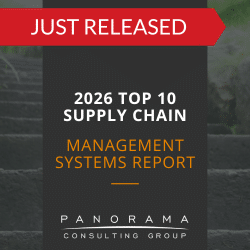Manufacturers are always looking for ways to make their supply chains run more smoothly and effectively. Increasingly, manufacturers are turning to advanced technologies, such as artificial intelligence (AI), to help them expand their capabilities, meet immediate buyer needs, and adapt to changing labor requirements.
Today, we’re looking at supply chain digital transformation and talking about why your organization may want to consider it.
2025 Top 10 Manufacturing ERP Systems Report
Are you a mid- to large-sized manufacturing firm? This report is for you. Download it now to learn what kind of advanced functionality is available in the market today.
Investing in the Tools of the Future
According to one recent report, 93% of industrial manufacturers say that AI functionality is at least moderately functional in their organizations. Of those, 49% have this digital strategy fully functional at scale.
What purpose does this technology serve beyond giving companies the right to claim competitive relevancy and technical prowess?
Put simply, modern enterprise technology is a risk mitigator. This digital technology allows companies to gain real-time visibility into every part of their value chain.
With this level of transparency, nothing goes unnoticed. Business leaders can identify areas of potential risk before an issue occurs or respond quickly to a disruption as soon as they find it.
The best part? Human intervention is minimal. With tools such as internet-connected sensors, companies can automatically adapt their production flows in response to a disruption or quality problem, minimizing the need for extensive IT support.
5 Benefits of Supply Chain Digital Transformation
1. Real-Time Data at Every Turn
Companies that don’t have access to intelligent features and robust data analytics will fall behind companies that know where their raw materials are at every moment.
Digital solutions, such as automated warehousing and remote fleet management, provide that level of insight from anywhere, at any time. With a few clicks, companies can easily see the status and location of each asset and can update their customers and partners accordingly.
For an even more granular approach to asset tracking, executives can employ tools like cloud-based GPS systems and Bluetooth low energy (BLE) systems to instantly see where their products are in real-time, even when they’re in transit.
Not only does this help them gauge the performance of their fleet, but they can also learn about route delays and create workarounds to avoid them.
2. More Accurate Demand Forecasting
Before digitization, companies relied mostly on historical models and past trends to predict their future product demands. While that might have worked at the time, today’s buyers aren’t as predictable because they have many more options and aren’t visiting the same brands for the same products every time.
With AI tools, businesses can use predictive analysis and machine learning capabilities to prepare for and plan around customer behavior.
For example, using embedded sensor technologies, companies can more accurately predict demand, identify buying patterns, and anticipate market shifts.
3. Always-Connected Data Threads
Historically, there’s been somewhat of a disconnect between supply chain partners and end users. A buyer might want a certain product but notice that it’s out of stock. They contact their local store, only to hear that there’s no data on where the materials are or when the inventory will be replenished.
Digital tools are changing this scenario and creating what’s known as an endless “data thread” that connects all consumers, both upstream and downstream. This thread not only connects data and systems but also workflows and team members.
This change represents a shift from thinking of a supply chain as a supply network to thinking of it as a comprehensive value chain. In this environment, suppliers can communicate and collaborate directly with customers to make every step more efficient and cost-effective.
In addition, businesses can use business intelligence to better gauge supplier performance and buyer behaviors and use this data to make each touchpoint more responsive.
4. Ability to Meet Customer Expectations
Buyers are more discerning than ever before. They now have almost zero tolerance for any type of inconvenience during their brand interactions.
They especially won’t stand for orders that are delayed or incorrect in any way. If they do experience such a setback, their response is simple: They’ll switch to a competitor.
Knowing this, companies are looking to digital technologies, like SCM software, to optimize every area of their logistics and distribution. As a result, these companies are finding that every step of every workflow, from warehousing to shipping, is completed at a breakneck pace.
In addition, many companies are choosing to move away from direct store models and onto centralized distribution and inventory management platforms. This enables them to become less dependent on warehouse inventory and more responsive to customer demands.
5. A Culture of Change
Along with an automated, digital supply chain comes the need for an expanded employee skill set. In other words, team members need to understand how to effectively use any new tools.
While supply chain management activities traditionally centered around manual tasks, today’s employees must be able to successfully monitor and guide intelligent software and machines. Then, they must learn how to access and analyze the data that these machines produce.
The need for these skill sets is changing the way companies recruit and retain talent by shifting their focus to digitally-competent individuals.
Skill gaps underscore the importance of not only smart recruitment strategies but the importance of organizational change management, as well. With the right change management methodology, companies can help team members navigate organizational changes with minimal resistance.
At the same time, these companies can use change management to ensure that their company culture prioritizes collaboration and continuous improvement.
In contrast, companies that fail to focus on the people side of digital transformation will only achieve limited benefits from intelligent technologies.
Technology is Changing Supply Chain Management
The most successful companies will be those that leverage modern technology to increase data visibility within their supply chain and improve their ability to meet customer demands.
Will this be your company? If so, the first step is a thorough selection process. Rather than selecting a solution because it’s the latest on the market, look for solutions that address your pain points and business needs. Then, create a culture of change so you can ensure all team members are ready to support the implementation.
Our enterprise software consultants can help you jumpstart your supply chain digital transformation. Contact us below for a free consultation.













